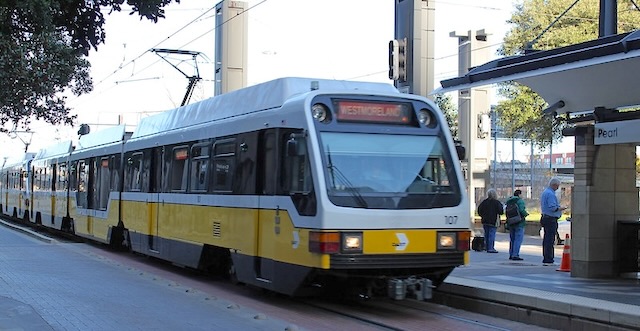As of June, the Dallas Area not-so-Rapid Transit (DART) was carrying 80 percent of pre-pandemic riders, a little more than the national average of 75 percent. The decrease in ridership has minimal effect on its budget, since in 2019 fares covered less than 12 percent of operating costs. Still, officials of several cities in the region whose taxpayers are supporting DART are beginning to wonder why they are spending so much money and getting so little.
DART has spent more than $5.5 billion ($8.0 billion in today’s dollars) in capital costs building a light-rail system that has done very little for the region’s transit ridership. Photo by Jeffrey Beall.
DART is primarily funded out of a 1 percent sales tax levied on residents of 13 cities served by the agency. Since early July, the city councils of six of those cities have voted to reduce the sales tax going to DART by 25 percent, and the city councils of Dallas and at least one other city are considering similar resolutions. The tax is levied by DART, not the cities, so the votes are more symbolic of general dissatisfaction with how DART is run. To actually reduce the tax, the DART board would have to put a measure on the ballot and residents of each of the 13 cities would decide.
The councillors who voted to reduce DART subsidies are “not against public transportation,” says the mayor of one of those cities. Instead, they want ” efficient system that does not over-rely on taxpayer dollars to service approximately 4% of individuals in DFW.”
Four percent is probably too high. Data from before the pandemic indicate that just 2.8 percent of workers living in the 13 DART cities took transit to work. While the 2022 American Community Survey has data for just the four largest cities, only 1.4 percent of workers in those cities were taking transit to work in that year.
This isn’t the first time city officials have questioned DART spending. DART was created in 1983 when voters in 15 cities agreed to a sales tax to support the regional agency. But when DART began planning expensive light-rail lines, two of those cities — Flower Mound and Coppell — voted to withdraw from DART in 1988. It is worth noting that, since then, those two cities have grown much faster than the rest of the region, showing that transit isn’t an essential part of economic development as agencies often argue.
Although only 36,000 people (out of 1.3 million workers in the 13 cities) relied on transit to commute to work before the pandemic, and probably under 20,000 people continue to do so, reporters naturally find one of those people to illustrate the hardships that a reduction in subsidies might create. That person is capable of driving but “lost his car” and so is dependent on transit. The question is whether transit is an efficient way to serve those people.
DART expects to collect over $900 million in sales taxes next year. That’s approximately $45,000 per transit commuter, enough to buy every one of them a well-equipped Tesla Model 3. Even if the number of transit commuters has grown since the 2022 American Community Survey, DART does not seem to be an efficient use of the region’s funds.
Of course, not everyone who rides DART is a commuter. But in 2019, transit in the greater Dallas-Fort Worth area carried just 0.6 percent as many passenger-miles as automobiles, a number that dropped to 0.4 percent in 2022. As of 2022, only 27,000 workers in the city of Dallas lived in households that had no vehicles, and more of them (5,769) drove alone to work than took transit (4,382). Even before the pandemic, the average resident of the DART service area rode transit only 28 times per year.
Transit is anything but vital to Dallas or its suburbs. Kudos to the city officials who are beginning to recognize that.









According to a presentation in the agenda for this month’s meeting of the regional council (NCTCOG), transit ridership is 28% below pre-pandemic levels. That number is for three agencies in the Dallas area, not just DART.
See page 4
https://www.nctcog.org/getmedia/0aecfebb-4906-43e5-96ab-18d2b5d9a291/presentationsrtc08082024.pdf?ext=.pdf
What happens when today’s modern, safer and larger vehicles are forced to navigate antiquated, overly dense environments that urban planners are trying to force all of us to live in?
https://www.wral.com/story/caught-on-camera-jeep-crashes-into-raleigh-cigar-shop/21580835/
$900 million in sales taxes on local businesses…. to finance a struggling rail system that costs over 8x more to run than it’s patronage supports provides to provide car-free transportation so local businesses can be Patroned?
When DART was proposed some 40-odd years ago, the shakers and movers of the region were up front with the voters: the rail transit scheme wasn’t about transportation, it was about ‘development’. They wanted the rail transit system to help promote a world-class image of the region to attract business and growth. The tax ‘revolt’ indicates a new generation of leadership has come to power, facing new demographics and new realities.
Anyway, if you like trains (and who doesn’t!), come to Dallas-Fort Worth. There’s 93 miles of electric light rail (including a tunnel with a subway stop), 34 miles of heavy rail, a combined 61 miles of diesel-electric light rail (with 26 more miles under construction), an innovative 2.6 mile hybrid battery/trolley street car line and a 4.6 mile heritage streetcar line with historical rolling stock.